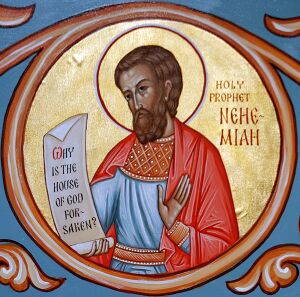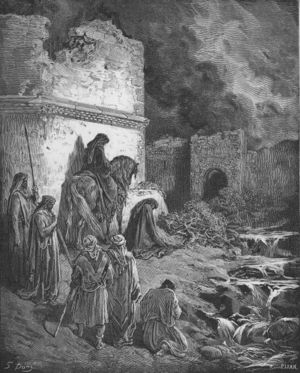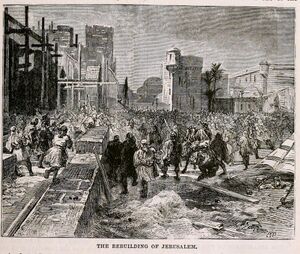نحميا
| نحميا Nehemias | |
|---|---|
 أيقونة يونانية | |
| قديس، زعيم، بني إسرائيل، نبي | |
مكرّم في | الكنيسة الكاثوليكية، الكنيسة الأرثوذكسية الشرقية |
| عيده | 13 يوليو |
نحميا (נְחֶמְיָה، "عزاء الرب"، تطويل لاسم "ناحوم" وتعني المُعزّي؛[1])،
هو الشخصية المحورية في سفر نحميا الذي يصف أعماله في إعادة بناء القدس أثناء فترة الهيكل الثاني. وكان حاكم يهودا الفارسية تحت أردشير الأول (465–424 BC).[1][2] وينطق الاسم في الإنگليزية إنگليزية: Nehemiah؛ /ˌniːəˈmaɪə/ أو /ˌniːhəˈmaɪə/. وبالعبرية נְחֶמְיָה، Nəḥemyāh، "ياه يعزّي".[1]
يعتقد معظم الدارسين أن نحميا كان شخصية تاريخية حقة وأن مذكرات نحميا، الاسم الذي أطلقه الدارسون على أجزاء معينة من السفر المكتوب بضمير المتكلم، هو وثيقة تاريخية يمكن الاعتماد عليها.[3][4][5]
سردية سفر نحميا
في العام 20 من عهد أردشير الأول (445 أو 444 ق.م.)، كان نحميا ساقي الملك.[6] Learning that the remnant of Jews in Judah were in distress and that the walls of Jerusalem were broken down, he asked the king for permission to return and rebuild the city.[7] Artaxerxes sent him to Judah as governor of the province with a mission to rebuild, letters explaining his support for the venture, and provision for timber from the king's forest.[8] Once there, Nehemiah defied the opposition of Judah's enemies on all sides—Samaritans, Ammonites, Arabs and Philistines—and rebuilt the walls within 52 days, from the Sheep Gate in the North, the Hananeel Tower at the North West corner, the Fish Gate in the West, the Furnaces Tower at the Temple Mount's South West corner, the Dung Gate in the South, the East Gate and the gate beneath the Golden Gate in the East.
Appearing in the Queen's presence[9] may indicate that he was a eunuch,[10] and in the Septuagint, the Greek translation of the Hebrew Bible, he is described as such: eunochos (eunuch), rather than oinochoos (wine-cup-bearer). If so, the attempt by his enemy Shemaiah to trick him into entering the Temple is aimed at making him break Jewish law, rather than simply hide from assassins.[11]
He then took measures to repopulate the city and purify the Jewish community, enforcing the cancellation of debt, assisting Ezra in promulgating the law of Moses, and enforcing the divorce of Jewish men from their non-Jewish wives.

After 12 years as governor, during which he ruled with justice and righteousness, he returned to the king in Susa. After some time in Susa he returned to Jerusalem, only to find that the people had fallen back into their evil ways. Non-Jews were permitted to conduct business inside Jerusalem on the Sabbath and to keep rooms in the Temple. Greatly angered, he purified the Temple and the priests and Levites and enforced the observance of the law of Moses.
ينسب إليه سفر نحميا الذي كتبه مؤلف مجهول الذي بين سنة 350 إلى سنة 300 ق.م.[12]
سفر المكابيين
The Second Book of Maccabees says Nehemiah is the one who brought the holy fire for the altar back from the diaspora to Jerusalem and founded a library of the Holy Scriptures just as Judas Maccabeus did. Here, Nehemiah’s political role sets an example for the Hasmonean dynasty and becomes a role model for pious, national leadership in general. The scene of reading and explaining the Torah in Neh 8 became the model of synagogue worship.[13] See 2 Maccabees 2:13.
سفر سيراخ
Ben Sira’s hymn in praise of the fathers mentions only Nehemiah (not Ezra) after Zerubbabel and Joshua and praises him for his building activities (Sir 49:15).
الأدب الحاخامي
One rabbinic text, or aggadah, identifies Nehemiah as Zerubbabel, with the latter being considered an epithet and indicating that he was born in Babylon. Another oral tradition, or mishnah, records that Nehemiah was blamed for seeming to boast (Neh. v. 19 & xiii. 31), and disparage his predecessors (Neh. v. 15). This tradition asserts that his book was appended to the Book of Ezra, as a consequence, rather than being a separate book in its own right, as it is in the Christian Old Testament. Another Talmudic text, or Baba Bathra, records that Nehemiah completed the Book of Chronicles, which was said to have been written by Ezra.[14]
في الفن
Samuel Taylor Coleridge commented on the dearth of a classical painting featuring Nehemiah.[15]
التبجيل
Nehemias is venerated in Catholic Church and Orthodox Church:
- 13 July – commemoration (Catholic Church),[16]
- Sunday of the Forefathers – movable holiday on Sunday that falls between December 11-17.[17]
انظر أيضاً
المصادر
- ^ أ ب ت Gesenius, Friedrich Wilhelm (1846). Gesenius' Hebrew-Chaldee Lexicon. Baker Book House; 7th edition, 1979. p. 544. ISBN 0801037360. خطأ استشهاد: وسم
<ref>غير صالح؛ الاسم "GHCL" معرف أكثر من مرة بمحتويات مختلفة. - ^ James D. G. Dunn; John William Rogerson (19 November 2003). Eerdmans Commentary on the Bible. Wm. B. Eerdmans Publishing. p. 321. ISBN 978-0-8028-3711-0. Archived from the original on 14 October 2020. Retrieved 10 August 2019.
- ^ For confirmation that many scholars share this view, see Anne Fitzpatrick (2009). Zuleika Rodgers; Margaret Daly-Denton; Anne Fitzpatrick Mckinley (eds.). "What did Nehemiah do for Judaism," in A Wandering Galilean: Essays in Honour of Seán Freyne. BRILL. pp. 93–. ISBN 978-90-04-17355-2.
- ^ For confirmation that most scholars share this view, see Jack Pastor (2010). Menahem Mor; Friedrick V. Reiterer (eds.). "The Contribution of the Samaria Papyri from Wadi Daliyeh to the Study of Economics in the Persian Period," in Samaritans: Past and Present: Current Studies. Walter de Gruyter. pp. 52–. ISBN 978-3-11-019497-5.
- ^ For an author who disagrees with the scholarly majority position on the historicity of Nehemiah and Ezra, but acknowledges the existence of that majority, see Philip R. Davies (3 September 2014). Rethinking Biblical Scholarship: Changing Perspectives 4. Taylor & Francis. p. 108. ISBN 978-1-317-54443-2. Archived from the original on 15 February 2017. Retrieved 8 September 2017.
The essential historicity of the events described [in Ezra and Nehemiah] has rarely been questioned.
- ^ On the date, see Ezra-Nehemiah: A Commentary. Westminster John Knox Press. 1 January 1988. p. 140. ISBN 978-0-664-22186-7.
- ^ Nehemiah 1:1-2:5
- ^ Nehemiah 2:6-9
- ^ Nehemiah 2:6
- ^ R. J. Coggins. The books of Ezra and Nehemiah (Cambridge: Cambridge University Press, 1976), 73; also F. Charles Fensham, The Books of Ezra and Nehemiah (Grand Rapids, MI: Eerdmans, 1982), 140
- ^ John Barton, The Oxford Bible commentary, Oxford University Press, 2001
- ^ معجم أعلام المورد. بيروت: دار العلم للملايين. 1992. p. 453.
{{cite book}}: Cite has empty unknown parameters:|lay-date=,|subscription=,|nopp=,|last-author-amp=,|name-list-format=,|lay-source=,|registration=, and|lay-summary=(help) - ^ Bergren, Theodore A. "Nehemiah in 2 Maccabees 1:10-2:18". Journal for the Study of Judaism in the Persian, Hellenistic, and Roman Period, vol. 28, no. 3, 1997, pp. 249–270. JSTOR 24668403. Retrieved 2 May 2020.
- ^ Nehemiah by Emil G. Hirsch, David Samuel Margoliouth, Wilhelm Bacher & M. Seligsohn, in "The Jewish Encyclopedia: A Descriptive Record of the History, Religion, Literature, and Customs of the Jewish People from the Earliest Times to the Present Day", Funk & Wagnalls, New York 1901-6.
- ^ Paley, Morton D. (10 July 2008). Samuel Taylor Coleridge and the Fine Arts. OUP Oxford. ISBN 9780191552724. Archived from the original on 26 August 2022. Retrieved 2 April 2018 – via Google Books.
- ^ Zeno. "Lexikoneintrag zu »Neemias (1)«. Vollständiges Heiligen-Lexikon, Band 4. Augsburg ..." www.zeno.org (in الألمانية). Retrieved 2023-02-03.
- ^ "Святой Нееми́я, вождь иудейский". Православный Церковный календарь (in الروسية). Retrieved 2023-02-03.
 هذه المقالة تضم نصاً من مطبوعة هي الآن في المشاع: Easton, Matthew George (1897). "Nehemiah". Easton's Bible Dictionary (New and revised ed.). T. Nelson and Sons.
هذه المقالة تضم نصاً من مطبوعة هي الآن في المشاع: Easton, Matthew George (1897). "Nehemiah". Easton's Bible Dictionary (New and revised ed.). T. Nelson and Sons. {{cite encyclopedia}}: Cite has empty unknown parameters:|HIDE_PARAMETER8=,|HIDE_PARAMETER9=, and|HIDE_PARAMETER7=(help); Invalid|ref=harv(help)
قراءات إضافية
- Barr, James. 'History of Israel' in History and Ideology in the Old Testament (Oxford: Oxford University Press, 2000), 87
- Holman Bible Dictionary, Persia
- Lester Grabbe. Ezra, in Eerdmans Commentary on the Bible (ed. James D. G. Dunn, John William Rogerson, Eerdmans, 2003) p. 320-1
- Pakkala, Juha. "Ezra the scribe: the development of Ezra 7-10 and Nehemiah 8" (Walter de Gruyter, 2004) pp. 225–7
- Schulte, Lucas L. My Shepherd, though You Do not Know Me: The Persian Royal Propaganda Model in the Nehemiah Memoir (Leuven: Peeters, 2016), 197-204.
- Williamson, H. G. M. Ezra and Nehemiah (Sheffield: Sheffield Academic Press, 1987), 17
- Wright, Jacob. "Rebuilding identity: the Nehemiah-memoir and its earliest readers" (Walter de Gruyter, 2004) p. 340
وصلات خارجية
- CS1 الألمانية-language sources (de)
- CS1 الروسية-language sources (ru)
- Short description is different from Wikidata
- Articles containing إنگليزية-language text
- Pages using Lang-xx templates
- مقالات المعرفة التي تضم نصاً من قاموس إيستون للكتاب المقدس
- شخصيات من الكتاب المقدس العبري
- شخصيات من الكتاب المقدس في الأدب الحاخامي
- عزرا-نحميا
- يهود القرن الخامس ق.م.
- ساتراپات الامبراطورية الأخمينية
- Biblical figures in rabbinic literature
- Cup-bearers
- Biblical patriarchs
- Book of Numbers people
- Christian saints in unknown century
- Roman Catholic royal saints
- Eastern Orthodox royal saints
- Urban planners
- Israeli urban planners
- Prophets of the Hebrew Bible
- Christian saints from the Old Testament
- Persian saints
- Christian royal saints

